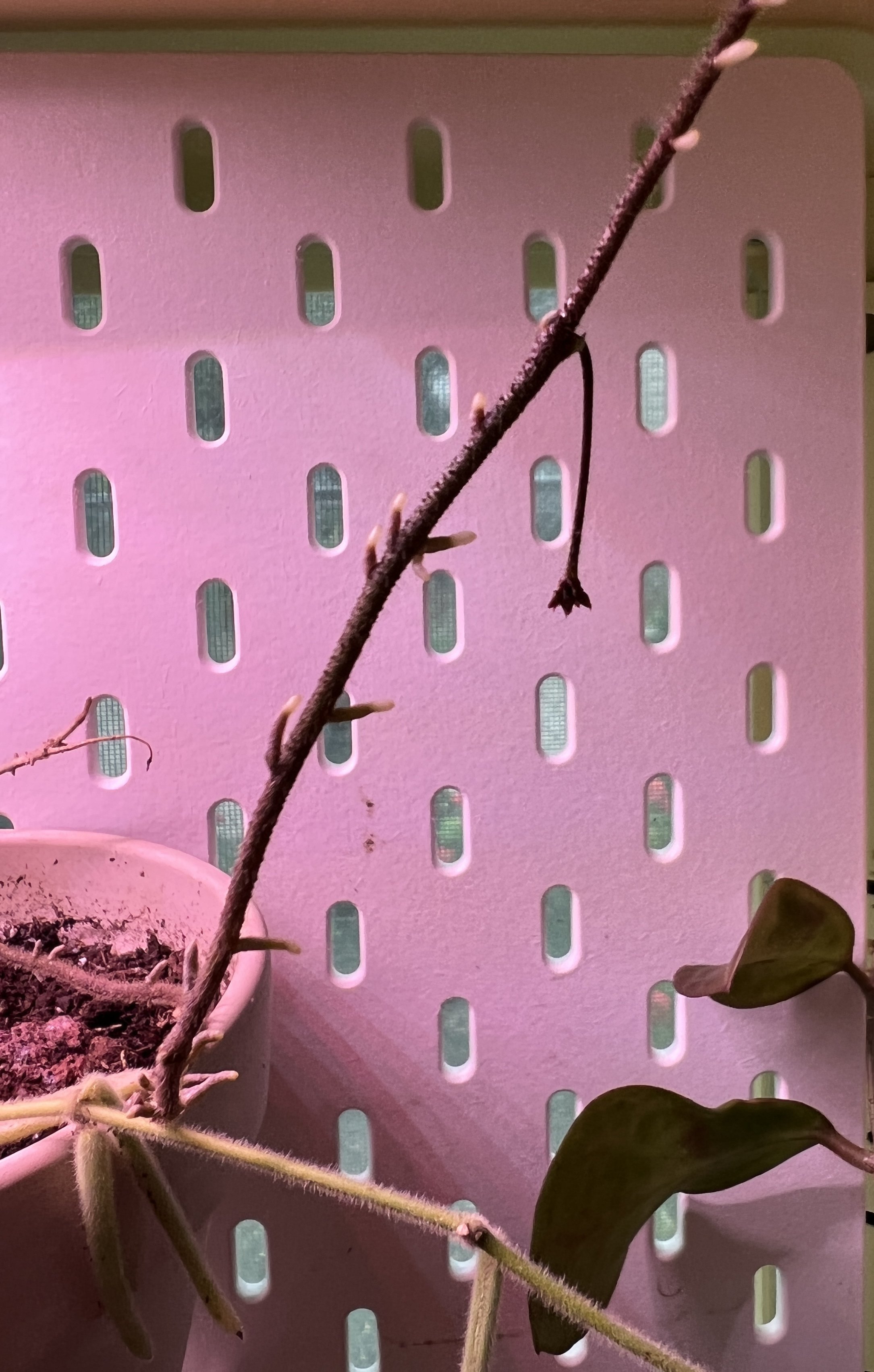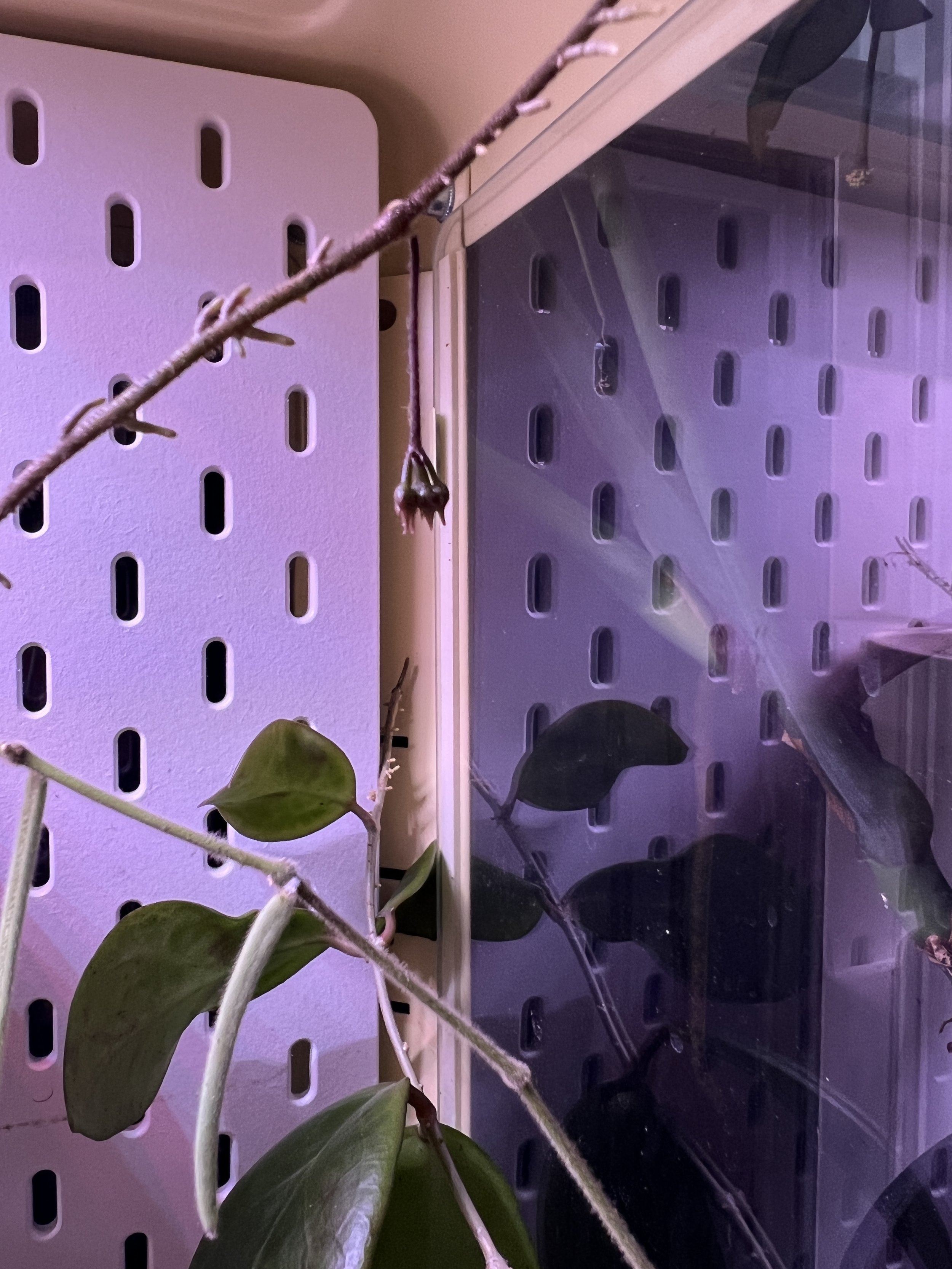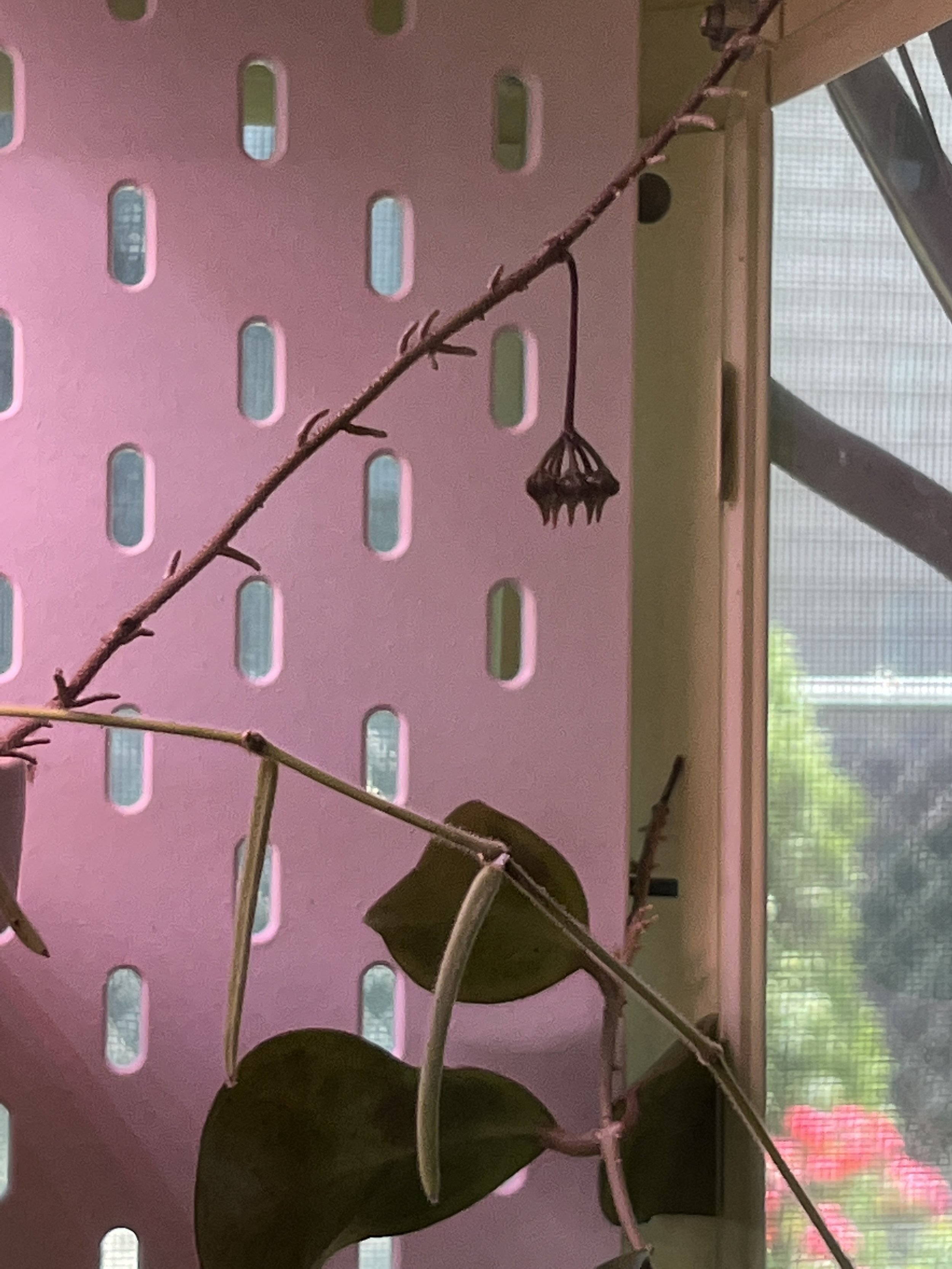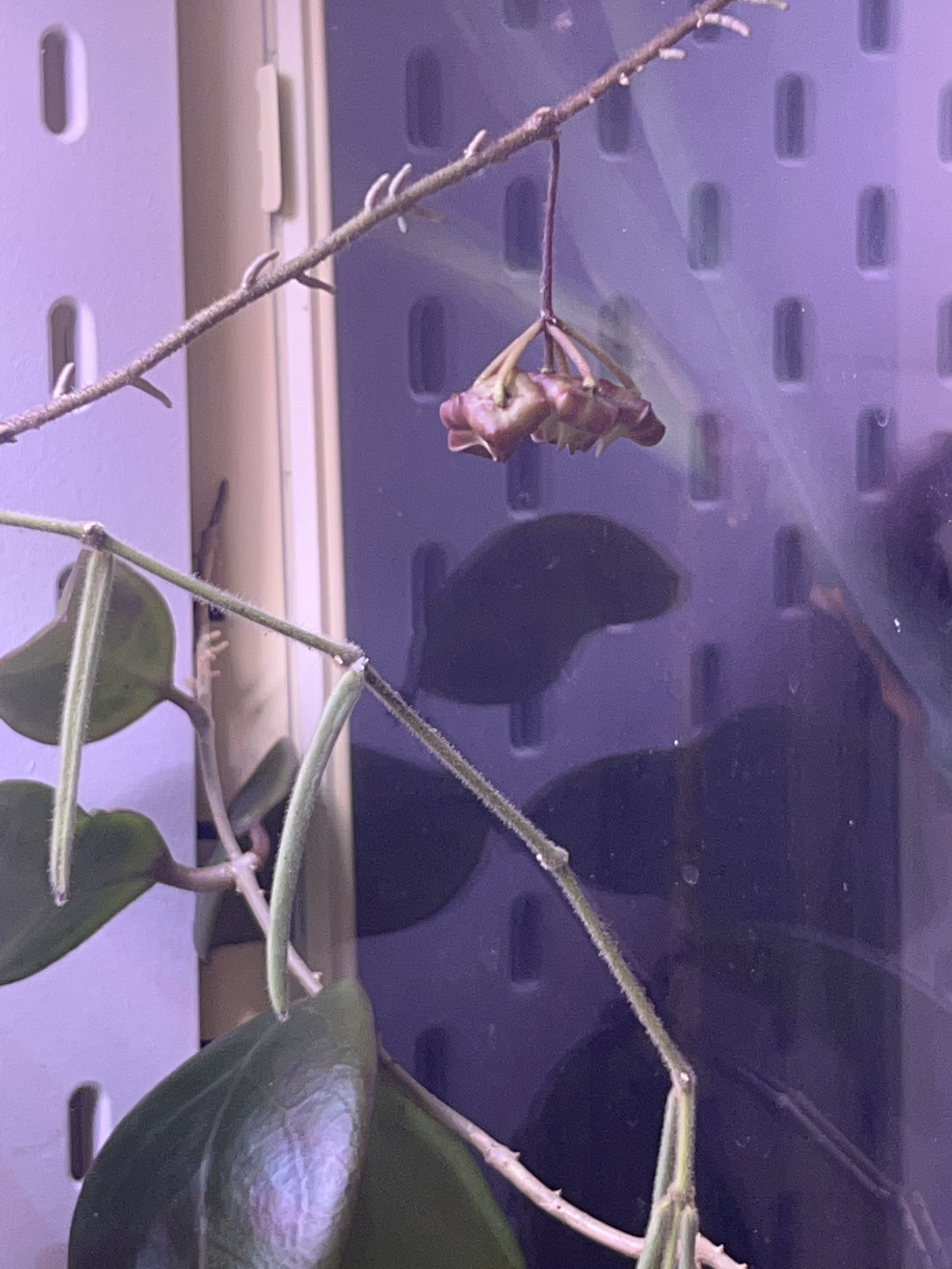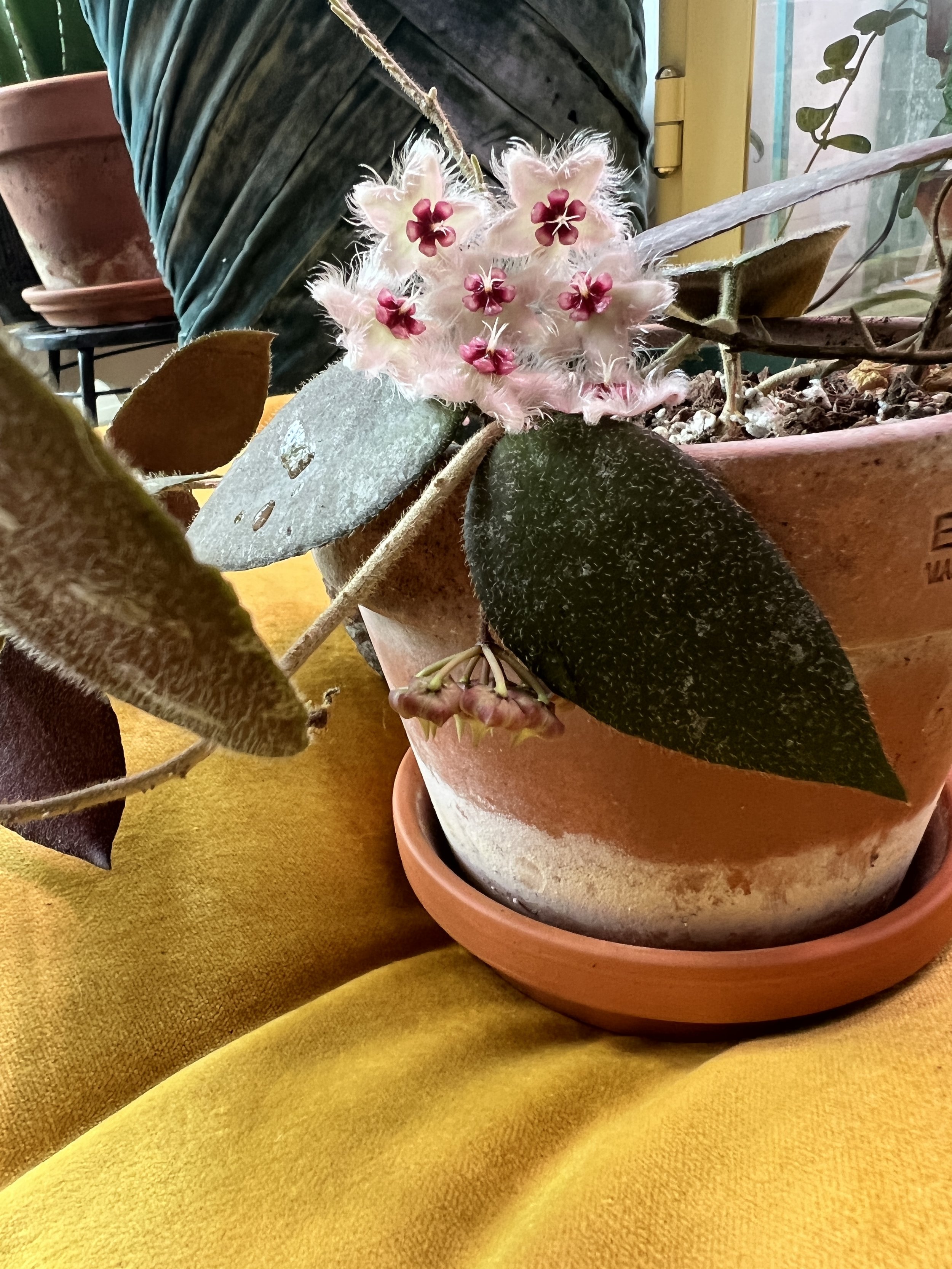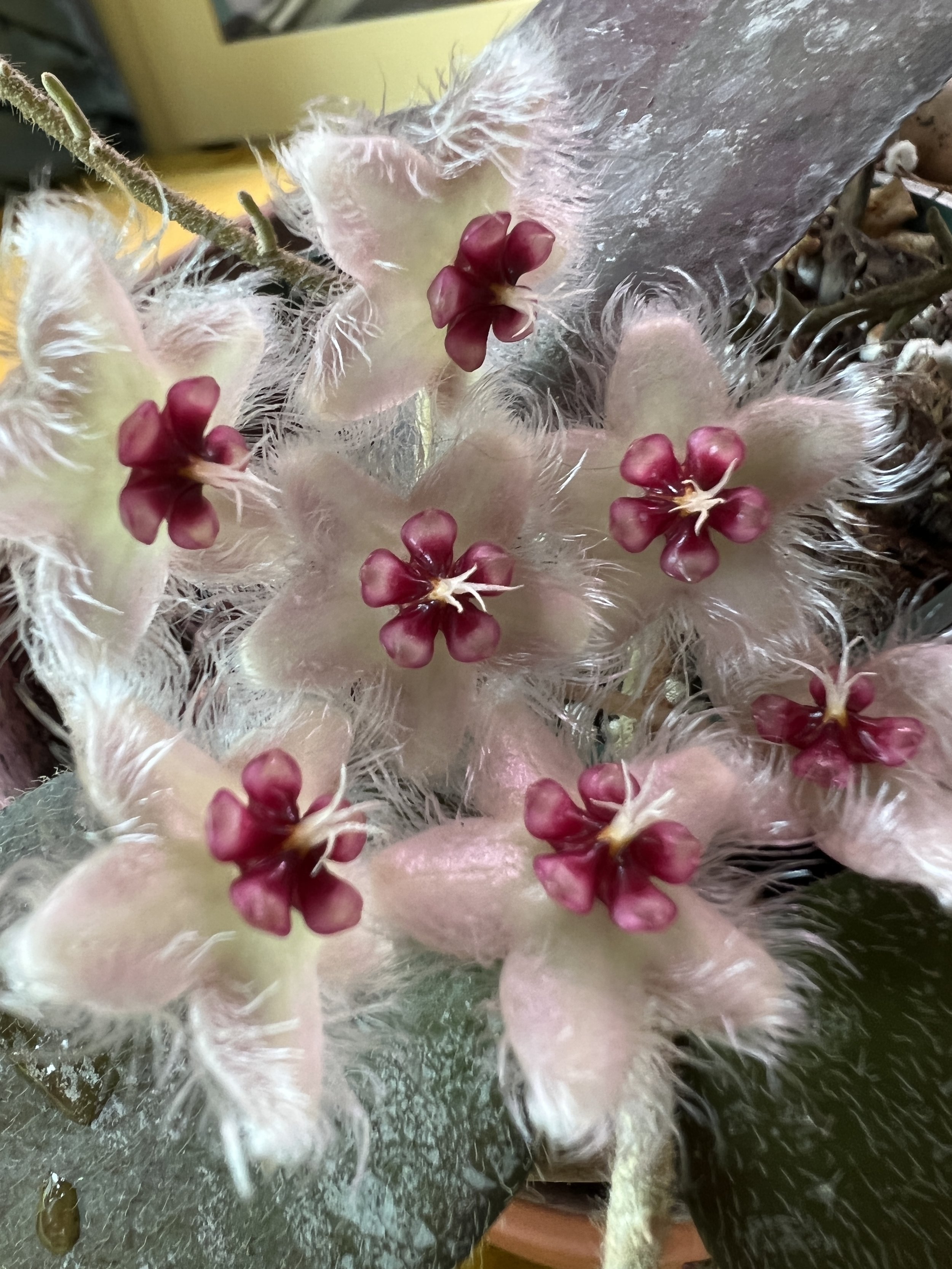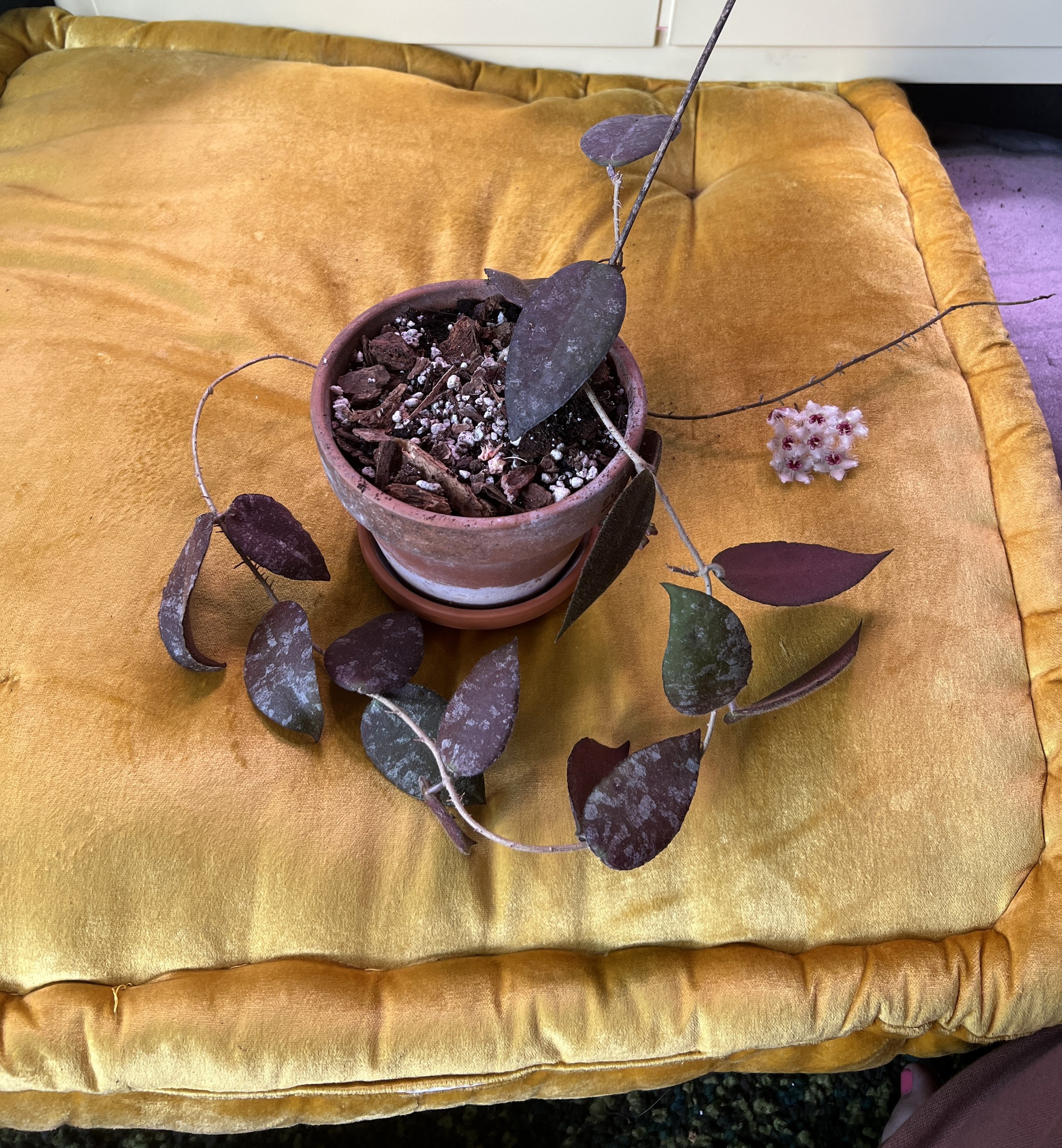Hoya caudata ‘Sumatra’ Profile
I’ve been taken with Hoya caudata ‘Sumatra’ since the first time I saw it. As a Hoya lover, I have a place in my heart for each and every one of them, but this one is a stunner in so many ways. The deep, olive green leaves with silvery splashes would be a sight to behold on their own, but the fuzzy texture takes them to another level. The fine, twiggy vines look so fragile that I’m surprised they can bear the weight of the substantial leaves. It’s a beautiful, and somehow functional contradiction. The peduncles are almost prehistoric when they form, and even more so as the buds swell with growth. And then then I got to see the plant in bloom. By the time that happened, I wished I had a Hoya caudata ‘Sumatra’ in every single room of my house.
This is my experience with growing Hoya caudata ‘Sumatra.’ My plant has always grown inside of one of my greenhouse cabinets, so I can’t attest to its growth potential in regular household conditions. I didn’t want to take any risks with this one. I was intimidated and very concerned that a plant with such a dramatic appearance must be so dramatic when it comes to care requirements. There was a space in my head that was fully prepared to watch this plant wither and die within a week, simply because I wasn’t willing to get my hopes up. I’m happy to report that this plant has been a joy to keep. Read on if you’re looking for a little bit of hope. I’ll tell the whole story of my plant and the lessons I’ve learned along the way, but for those who want to get straight to the key points, you can skip ahead using the table below.
Table of Contents
A Little Bit of Background
I purchased my HCS in June of 2021. It’s been just shy of two years since I began caring for it. It had three leaves on two short vines at that time, but it was well rooted. I started small intentionally because, like I said, I didn’t want to take any risks. I usually take a photo of a plant when I purchase it so I can keep track of growth and blooming, but I spaced out on this one for some reason.
Potting Mix and Terracotta
One of the first things I noticed upon receipt of this plant was how chunky the potting mix was inside the 4” nursery pot. I hadn’t really developed a plan on what sort of potting mix I was going to use, so I decided to keep up with the type of potting mix to which the plant was already accustomed. I could see that the plant was well rooted and seemed very happy. I trust the seller that I chose, so I have no reason to doubt her choice in potting medium. It came from Florida, where it had been growing outdoors in a covered but open greenhouse. That type of environment is a far cry from growing indoors in the Midwestern U.S., so I anticipated an adjustment period would follow our initial meeting.
The potting mix consisted of Orchid bark, perlite of various sizes, charcoal, and a little peat. See below.
I’ve learned that this plant does not like to have wet potting mix for very long. The chunky mixture helps the potting mix to dry out sooner, much like the plant would in a natural habitat, where Hoya would typically grow as epiphytes or lithophytes.
I use a terracotta pot because it’s breathable, so it prevents the area within the pot (especially the fragile root system) from drowning after watering. Plastic or glazed ceramic would allow moisture to trap along the walls. This was fine when my plant was a rooted cutting, but as it began to mature, I needed to make space for the roots. I repotted after about a year of owning the plant. The roots and vines had grown substantially, and I felt that it was safe to move onward with repotting. I mimicked the chunky potting mix that the plant had always known with the bark and perlite being close to 50/50. I added a small handful of general potting mix, and about a tablespoon of earthworm castings and blended well. I did not disturb the root ball when repotting. I gently shook it so that nay loose materials could fall away and very gently surrounded the root ball with new potting mix inside the terracotta. As always with repotting, it took a few rounds of watering before the potting mix and roots had fully settled into the new arrangement and there was no longer dust or debris coming out of the drainage hole. I find that, since this plant doesn’t like to have wet potting mix, gently aerating inside the pot is helpful.
As I repot in the future, this is the same recipe I will follow for this plant, with the focus being on a potting mix with large chunks.
Water and Humidity
With the proper potting mix in place for my plant, I have found water to be quite straightforward. I feel 2-3 leaves on the plant to check before watering. If the leaves feel rigid and firm as I gently squeeze them, I check again in a few days. If the leaves bend or wrinkle at all when I test them, it’s time to water the plant. I water the plant until the drainage tray is nearly full and allow the plant to slowly absorb the water over time. Generally, checking the amount of water left in the drainage tray in about 30 minutes is helpful. If all of the water has been absorbed, I will add more water to the drainage tray to ensure that the plant has gotten all the water it needs. If there’s standing water in the tray after 30 minutes, I remove it and consider the plant sufficiently watered. Unfortunately, there is no routine or set number of days to help me plan a watering schedule. I open the cabinet about once a week to monitor the plants. I find that opening it more frequently disturbs the humidity, and I don’t want that.
Humidity was my top concern when I was pondering the best ways to care for this plant. This is why I chose to keep it in my greenhouse cabinet. Below, the plant can be seen on the top shelf, back left.
These two photos were taken before I repotted the plant, the nursery pot is still visible within the terracotta in the first photo. I’ve since remodeled the yellow greenhouse cabinet seen here, and Hoya caudata ‘Sumatra’ moved to a different cabinet. See below.
Hoya caudata ‘Sumatra’ can be seen on the top shelf in the back left.
The temperature and humidity are very comparable in these two cabinets, which is why I felt fine making the move. They’re also equipped with the same grow lights, but more on that later. As far as the specifics, the humidity in these cabinets will range from 60-80%. It does fluctuate based on the time of year, and that’s probably true for most homes and/or cabinets. I’m happy if it stays above 60% because the plants seem perfectly satisfied with this arrangement.
At the time of measurement, the cabinet is at 74% humidity. The humidity meter has some issues, but I can still read it.
Light and Temperature
The grow lights that sit on top of both of these cabinets are Feit Electric 2ft. grow fixtures. They’re on timers that turn on at approximately 8:30 a.m. and automatically turn off at around 10 p.m. For those hours, this plant receives light that reads between a 6 and 7 on a light meter.
Close to pot level, the light reads at a 6 on my meter. As you can see there are three blooms near this level, so a 6 is sufficient to please this plant. I would consider the leaves medium sized at around 3 inches. Generally, I follow the idea that the larger the leaf, the less light a Hoya requires. This is a guideline that I follow with a caveat or two. First, you can probably see that the leaves have turned a reddish purple color in this light. Some call this “sun burn” or “sun stress.” Though this is a typical reaction to light, it probably means that this plant could tolerate less light. Second, I’ve had plenty of plants with smaller leaves (Hoya ‘Mathilde,’ Hoya serpens, Hoya nummularioides, or the Hoya fitchii seen in the photo above) that grow, bloom, and thrive in the same light. With those said, it’s probably best seen as a loose guideline, at least with this plant.
Where the longest vine grows, the light meter shows just a hair over a 7.
As far as temperature, I look for around 70 degrees. A range of 68-78 degrees is reasonable for my environment, and this plant seems more than satisfied with that.
Growth and Blooms
I was expecting slow growth from Hoya caudata ‘Sumatra,’ but that’s not what I got. I was surprised at how quickly this plant took off. It began with three leaves, and it got to about fifteen in a year. It grew so quickly, in fact, that I had to temporarily settle for a paperclip to hold the long, leafless end of the vine.
As for the blooms, I’ve found this plant to be prolific. The first blooms appeared just short of a year after purchase. It’s bloomed continuously since then. The hairy-looking flowers are otherworldly, but fairly short-lived compared to some other Hoya blooms. They only last about three days on my plant compared to others that can last around a week. Still, they make an impact in those three days. In the photo gallery below, you can see my documentation of the first time this plant bloomed.
It wasn’t until I removed the plant from the cabinet that I even noticed the second bloom spur.
Unfortunately, removing the plant from the cabinet to get closer photos of the first bloom was a lesson for me in the fragility of this plant. The vines are thin and woody, and they snap like a twig if bent beyond their threshold. I would not describe the vines as fibrous, at least not compared to other plants in my collection. They’re just very woody. The moisture content appears to be low compared to the leaves. Perhaps this explains the need for chunky soil and a vigilant eye when it comes to waterlogged potting mix.
The habit of this, in my experience, is very unique. Though it does readily grow sticky little fingers for grabbing onto surfaces, it doesn’t seek to cling and climb like some of my other Hoya. The vines aren’t the greatest at weight bearing, so hanging isn’t ideal. The twiggy vines would need to spiral around a trellis when they’re freshly grown, before hardening off. With all of this in mind, I just let my plant grow in its rambling, awkward way and I provide support in the cabinet as needed.
The Key Points
Chunky potting mix is a friend of HCS. Think bark, perlite, and charcoal.
Terracotta helps the contents of the pot dry out nicely between waterings, keeping the sensitive root system from sitting in waterlogged potting mix.
Watering based on the feel of 2-3 leaves has been a success. Soft, bendable leaves indicate a need for water. Firm, rigid leaves are already hydrated.
Humidity above 60% is great.
12+ hours of light are beneficial, 6-7 on a light meter. Aspiring for a 6 is perfectly adequate.
Temps from 68-78 degrees will be pleasing.
The vines have the potential to grow fast and break easily.
Blooms are otherworldly and prolific if the plant is provided with all of the above.
I can’t speak on HCS grown in typical household conditions as mine has always been grown inside a greenhouse cabinet with a controlled environment.
The End
This is just a summary of my experience with growing Hoya caudata ‘Sumatra.’ I found this plant to be enchanting, but somewhat intimidating. I hope that this information can be entertaining and informative to you if you’re also curious about this plant.
As always, thank you for reading and feel free to send me an email if you also love plants! I am finding myself less and less interested in the social media world, but you can always check out Instagram for past musing on plants, pottery, and probably cats.









